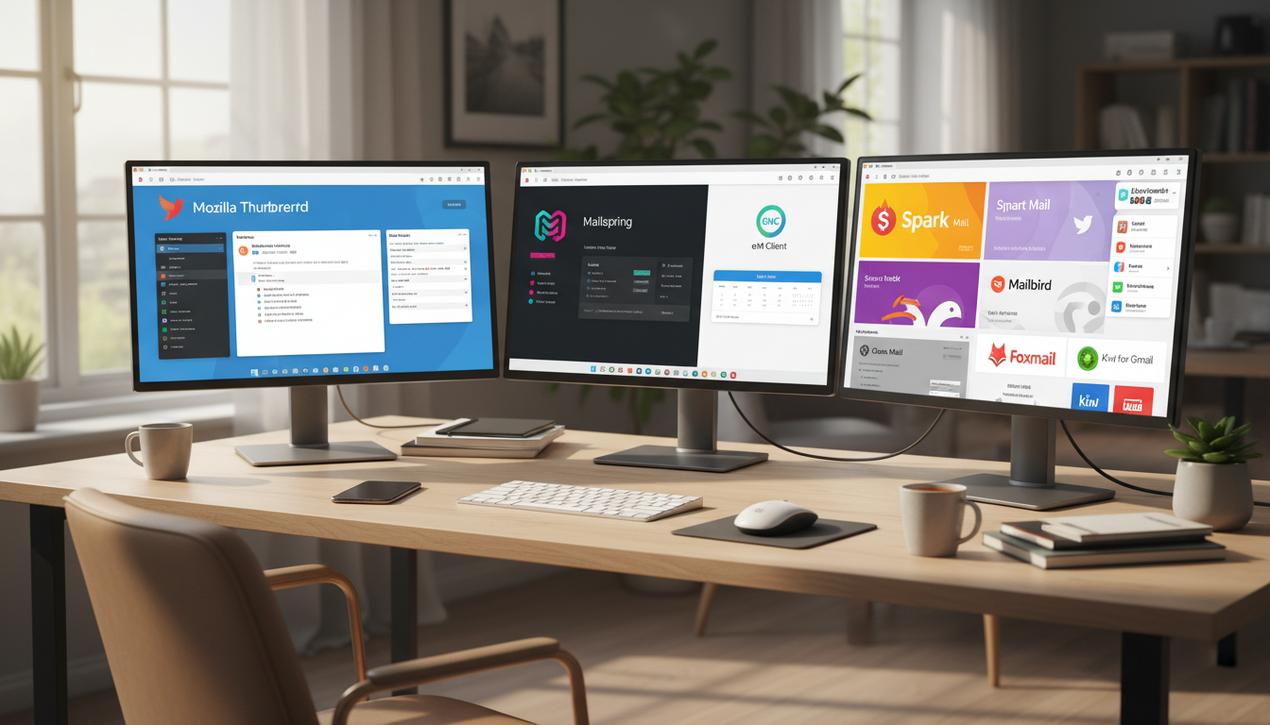Top 8 Free Email Clients to Use in 2025


Despite the rise of instant messaging apps, email remains the cornerstone of professional and personal communication. In 2025, over 376 billion emails are sent worldwide every day, a figure that underscores its central role in our digital lives. While webmail services like Gmail and Outlook.com are convenient for quick access, they often reveal their limitations when it comes to productivity, multi-account management, and privacy. This is where desktop email clients come in. These dedicated applications offer a centralized, feature-rich, and often more secure experience. Recent trends show a strong demand for tools that integrate artificial intelligence for smart sorting, a domain where many powerful AI alternatives exist, enhanced security features like end-to-end encryption, and seamless interoperability with calendars and other productivity tools. Whether you’re a freelancer juggling multiple addresses, a security-conscious professional, or simply seeking better organization, there is a free email client tailored to your needs. This comprehensive guide breaks down the 8 best free solutions for Windows, Mac, and Linux.
Why Use a Desktop Email Client in 2025?
In the age of the cloud, installing a dedicated software program to manage email might seem redundant. However, desktop email clients offer strategic advantages that web-based interfaces struggle to match. They address specific needs for performance, security, and efficiency, which explains their continued popularity among power users and professionals.
Centralized and Unified Management
The primary benefit of a desktop email client is its ability to consolidate all your email accounts—professional, personal, and otherwise—into a single, unified interface. Gone are the days of constantly switching between browser tabs. A unified inbox allows you to see all new messages at a glance, perform searches across all accounts simultaneously, and apply global sorting rules. This provides a significant boost in both time savings and mental clarity.
Enhanced Security and Privacy
Security is a paramount concern for modern communication. Desktop email clients generally offer more robust security options. Many support PGP/GPG encryption natively, ensuring that only you and your intended recipient can read your messages. Furthermore, your emails are stored locally on your machine, giving you complete control over your data, a principle also central to the use of the best cookie consent tools, unlike webmail where your information resides on third-party servers. Spam and phishing filters are also often more powerful and customizable.
Productivity and Offline Access
A desktop client downloads your emails directly to your computer. This means you can access your archives, read messages, and even compose new ones without an internet connection. Your drafts will be sent automatically as soon as you’re back online. This feature is invaluable for professionals on the move. Additionally, performance is often superior; searching through thousands of emails is nearly instantaneous because it happens locally, not on a remote server.
Our Selection of the 8 Best Free Email Clients
The market for free email clients is both rich and diverse. We have selected 8 high-performing tools that stand out for their features, usability, or philosophy, ensuring there are options for every major operating system.
1. Mozilla Thunderbird: The Open-Source Powerhouse
Developed by the Mozilla Foundation (the creators of Firefox), Thunderbird is the most famous open-source email client and one of the most comprehensive. Long considered a powerful alternative to Outlook, it has experienced a resurgence with recent major updates that have modernized its interface and expanded its feature set. It seamlessly integrates a calendar, task manager, RSS feed reader, and chat module.
- Key Features: Unified inbox, advanced folder management, powerful filtering, support for extensions to add functionality, and built-in PGP encryption.
- Best For: Privacy-conscious users and open-source enthusiasts looking for a complete and highly customizable solution.
- Platforms: Windows, macOS, Linux.
2. Mailspring: Modern Design and Performance
Mailspring stands out with its clean, modern, and intuitive interface. It offers a fluid and enjoyable user experience. Although its free version locks some advanced features like email tracking and reminders, it remains exceptionally capable for daily use. It offers multiple themes for personalization and includes integrated translation features.
- Key Features: Unified inbox, signature management, fast search, read receipts (limited in the free version), and enriched contact profiles.
- Best For: Users who prioritize aesthetics and ease of use without sacrificing performance.
- Platforms: Windows, macOS, Linux.
3. eM Client: The Complete Professional Suite
eM Client is a genuine alternative to Microsoft Outlook for professionals. It goes far beyond simple email management by integrating a calendar, tasks, contacts, and a chat service. Its interface is clean and professional. The tool greatly simplifies importing data from other clients (Outlook, Thunderbird) or webmail (Gmail), making the transition effortless. The main drawback of the free version is its limitation to two email accounts.
- Key Features: PGP integration, automatic backup, conversation view, and full integration with Google, Microsoft Exchange, and iCloud services.
- Best For: Professionals and small businesses who need a powerful all-in-one solution and can work within the two-account limit.
- Platforms: Windows, macOS.
4. Spark Mail: Intelligence for Your Inbox
Spark has reimagined email management with its “Smart Inbox” concept, which automatically sorts your emails into categories like personal, notifications, and newsletters. The goal is to help you focus on what truly matters. It also integrates collaborative features, such as the ability to draft an email with a team in real-time or comment privately on a message thread. The free version is very generous with its features.
- Key Features: Smart Inbox, email snoozing, follow-up reminders, scheduled sending, email templates, and third-party integrations (Trello, Asana, etc.).
- Best For: Teams and individuals looking to reduce inbox clutter and adopt a more organized approach to email.
- Platforms: Windows, macOS, iOS, Android.
5. Mailbird: The Communication Hub for Windows
Exclusive to Windows, Mailbird positions itself as a command center for all your communications. It merges emails, messaging apps (WhatsApp, Messenger), calendars, and productivity tools (Todoist, Asana) into a single, unified window. Its interface is highly customizable. The free version, “Lite,” is limited in features (one account) but remains an excellent choice for those wanting to test this integrated approach.
- Key Features: Integration with dozens of apps, a quick attachment previewer, LinkedIn profile lookup, and email snoozing.
- Best For: Windows users who want a single application to unify all their communication and productivity tools.
- Platforms: Windows.
6. Claws Mail: Lightweight and Fast Above All
Claws Mail is a no-nonsense email client. Its interface may look dated, but its strength lies in its incredible speed, stability, and low resource consumption. It is a powerful and highly configurable tool aimed at a more technical audience. Built on GTK+, it feels particularly at home in Linux environments.
- Key Features: Extremely lightweight and fast, stable, highly configurable, and supports numerous plugins to extend its capabilities (spam filters, archive format handlers, etc.).
- Best For: Developers and advanced users who work on older machines or prioritize raw performance over aesthetics.
- Platforms: Windows, Linux.
7. Foxmail: The Simple and Effective Alternative
Developed by Chinese tech giant Tencent, Foxmail is a highly popular email solution in Asia. Completely free, it offers all the essential features expected from a desktop client in a simple, user-friendly interface. It’s a solid choice for personal or professional use without any unnecessary frills.
- Key Features: Multi-account management, address book, calendar, integrated notepad, and support for standard email protocols.
- Best For: Users looking for a straightforward, comprehensive, and entirely free email client with a traditional feel.
- Platforms: Windows, macOS.
8. Kiwi for Gmail: For Fans of the Google Ecosystem
This client is different: it only handles Gmail and Google Workspace accounts. Its purpose is to transform the Gmail web interface into a powerful desktop application, adding native integrations with Google Drive, Docs, Sheets, and Calendar. It allows you to launch these apps in their own windows, separate from the browser. The free version is limited but functional for basic use.
- Key Features: Perfect integration of the Google ecosystem, native desktop notifications, the familiar Gmail interface, and multi-account support.
- Best For: Heavy users of Gmail and the Google Suite who want a dedicated and better-integrated desktop experience.
- Platforms: Windows, macOS.
How to Choose the Right Email Client for You
The “best” email client is ultimately the one that aligns with your workflow. To make the right choice, consider the following questions:
- Your Operating System: Ensure the software is compatible with your OS (Windows, macOS, or Linux).
- Number of Accounts: Check the limitations of the free version if you manage numerous email addresses.
- Privacy Concerns: If confidentiality is your top priority, lean towards open-source solutions like Thunderbird.
- Feature Needs: Do you need a simple email manager or a complete productivity suite with a calendar and tasks?
- User Interface: Do you prefer a modern, minimalist design (Mailspring, Spark) or a dense, information-rich interface (eM Client)?
Far from being obsolete, desktop email clients continue to evolve and adapt to the new challenges of digital communication. By centralizing your accounts, strengthening your security, and optimizing your workflow, the right software can transform email management from a chore into an efficient and controlled task. Don’t hesitate to test several options from our selection. Most offer a quick setup process, and you might be surprised by the boost in productivity and peace of mind that a well-suited tool can bring to your daily routine.




